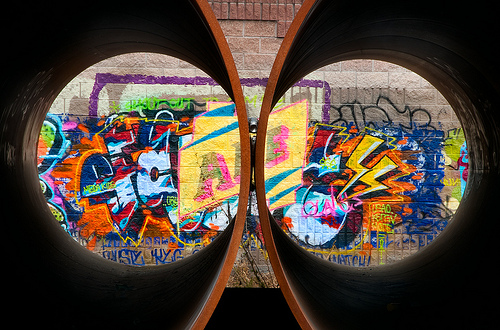An abandoned cement field in West Oakland near the docks was filled with large, rusting metal pipes, maybe ten feet in diameter. What was their original purpose? Why were they left behind? Who knows.
The vast area was fenced, but it had obviously been entered many times—getting in was no problem. Once inside I felt the need to stay alert regarding my surroundings, although as far as I could tell I shared the scene only with trash, weeds, wall art, and the gray sky of a misty day. The damp, overcast weather helped saturate the colors you see in this image.

As I often do these days in the field, I manually bracketed for HDR. Usually, this means about a 10 EV exposure range—plus, of course, whatever one can tease out of the RAW files. Specifically, for this image I shot ten exposures ranging from 1/200 of a second at the darkest end to 4 seconds at the lightest end. Each exposure was shot at 130mm, f/36, and ISO 200, using a tripod.
It turns out that this was definitely too much information! Running the combined exposures through HDR processing led to an average looking image that showed the interior of the pipes along with assorted booze bottles and trash. This was definitely not the look I wanted to achieve because I knew things would be much more dramatic with a contrast range between the blackness of the pipe interior and the riotous color of the graffiti on the wall behind.
So I reprocessed the image, mostly using a single exposure, to enhance the high contrast drama, adding a little color to the central paintings using a low opacity version rendered by Nik HDR Efex Pro 2.
If you look carefully, you can still see an old booze bottle caught between the two pipes. I could have retouched this out, but decided to leave the bottle in the image as a reminder of the authentic environment this image was made in.
The moral, of course, is that there is no real problem overshooting in the field. If I don’t need all the information, I can just discard it at the processing stage. Better to have it in case I need it, and end up not using it, than to regret undershooting. As experienced photographers know, mostly you can’t go back because things are never the same twice.